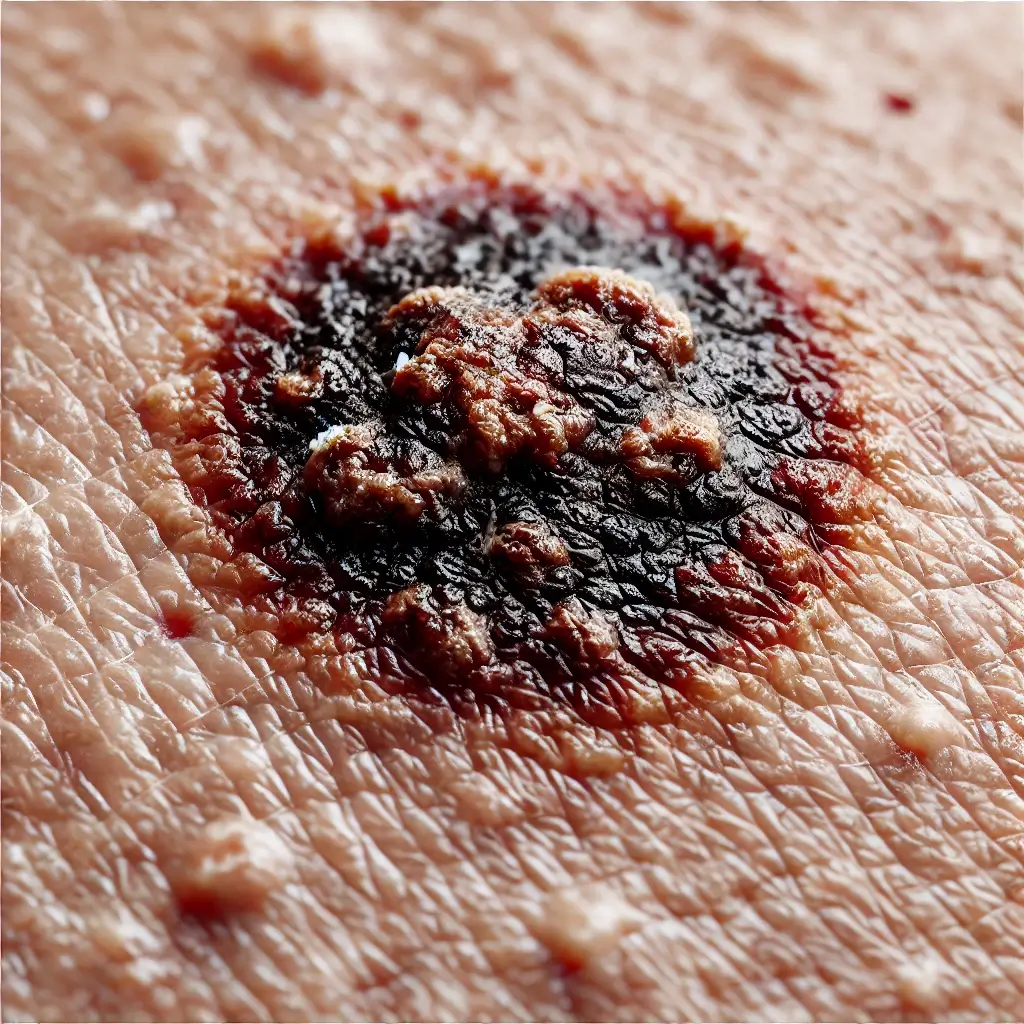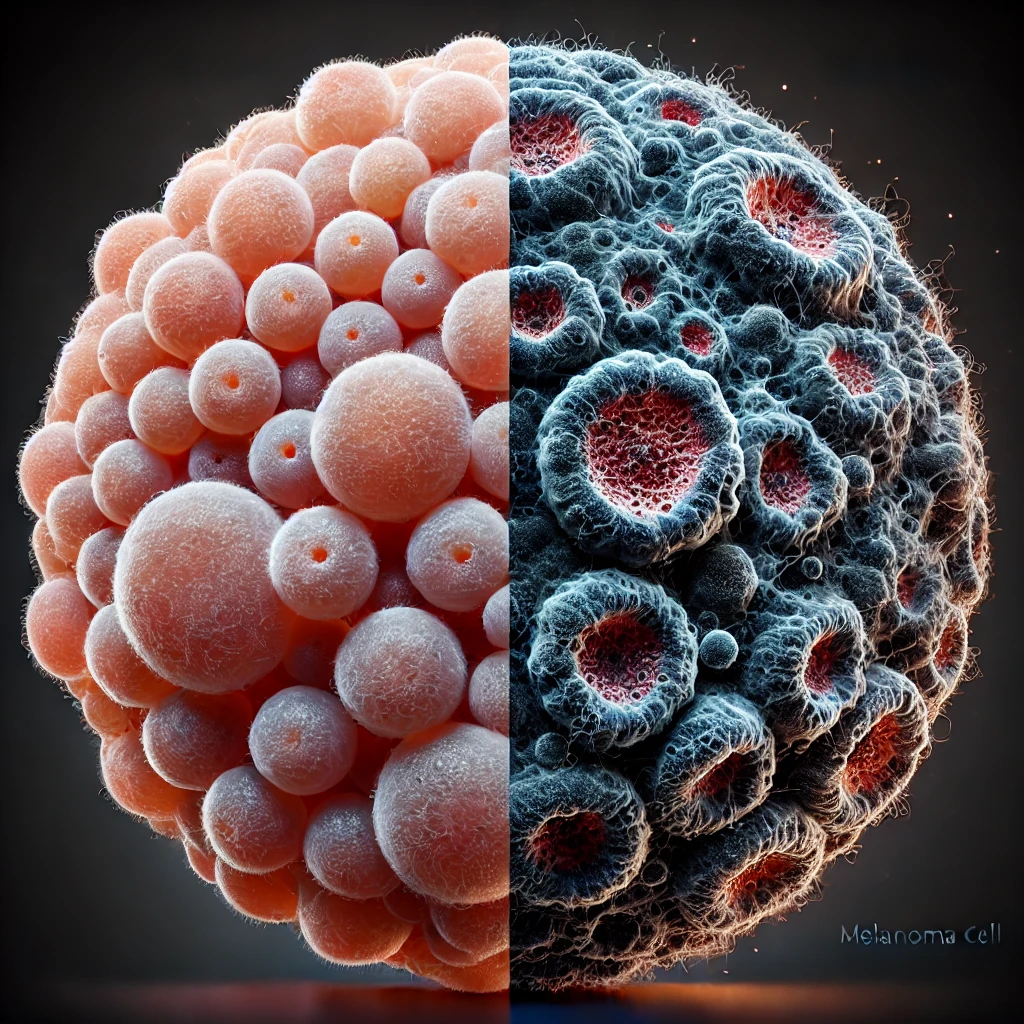Book Appointment Now
Understanding Melanoma

Melanoma Guide
Introduction
What Is Melanoma?
Melanoma is a serious type of skin cancer that develops in melanocytes, the cells that produce melanin—the pigment that gives your skin its color. Unlike other skin cancers, melanoma can spread to other parts of the body if not detected early.
Why Is It Important to Learn About Melanoma?
Melanoma is less common than other skin cancers, but is more dangerous because it can spread rapidly. Understanding melanoma is crucial because:
- Early Detection Saves Lives: When found early, treatment is often successful.
- Preventable Risk Factors: Many cases are linked to controllable factors like sun exposure.
- Advancements in Treatment: New therapies have improved outcomes for advanced melanoma.
Recent Developments:
- Improved Treatments: Immunotherapies and targeted therapies have significantly increased survival rates.
- Public Awareness: Increased education on sun safety and skin checks helps with early detection.
Statistical Overview
- Incidence: Melanoma affects about 1 in 50 people in the United States during their lifetime.
- Annual Cases: Over 100,000 new cases of melanoma are diagnosed in the U.S. each year.
- Mortality Rates:
- Approximately 7,000 Americans die from melanoma annually.
- Survival Rates:
- Early Detection: The 5-year survival rate is over 99% when melanoma is caught early.
- Advanced Melanoma: The 5-year survival rate drops to around 25% if it has spread to other organs.
Trends and Disparities:
- Increasing Incidence: Rates have been rising over the past few decades.
- Age Factors: Common in people under 30; one of the most common cancers in young adults.
- Gender Differences:
- Before Age 50: More common in women.
- After Age 50: Rates are higher in men.
- Geographic Differences: Higher rates in areas with intense sunlight like Australia and southern U.S. states.
Medical Illustrations
Anatomical medical illustration of melanoma:

Normal melanocytes alongside melanoma cells:

Risk Factors and Prevention
Known Risk Factors
- Ultraviolet (UV) Radiation Exposure:
- Sun Exposure: Spending a lot of time in the sun without protection increases your risk.
- Tanning Beds: Using indoor tanning devices exposes you to harmful UV rays.
- Fair Skin:
- Less melanin means less natural protection against UV radiation.
- Personal or Family History:
- Previous melanoma or skin cancer increases your risk.
- Having a close relative with melanoma raises your chances.
- Moles:
- Atypical Moles: Unusual moles (dysplastic nevi) can develop into melanoma.
- Many Moles: Having more than 50 moles increases risk.
- Weakened Immune System:
- Conditions like HIV/AIDS or medications that suppress immunity can elevate risk.
- Genetic Factors:
- Certain inherited genes can increase susceptibility.
- Age and Gender:
- Younger Women: Higher rates before age 50.
- Older Men: Higher rates after age 50.
Prevention
Protect Your Skin from UV Radiation:
- Use Sunscreen:
- Apply broad-spectrum sunscreen with at least SPF 30.
- Reapply every two hours and after swimming or sweating.
- Wear Protective Clothing:
- Long sleeves, hats, and sunglasses.
- Seek Shade:
- Especially between 10 a.m. and 4 p.m.
- Avoid Tanning Beds:
- They emit harmful UV rays.
Regular Skin Checks:
- Self-Examinations:
- Check your skin monthly for new or changing moles.
- Professional Exams:
- Visit a dermatologist annually.
Healthy Lifestyle Choices:
- Avoid Sunburns:
- Be extra cautious if you have fair skin or burn easily.
- Vitamin D Safely:
- Obtain vitamin D through diet or supplements.
Recent Studies Support:
- Sunscreen Use Reduces Risk:
Regular use can lower melanoma risk by 50% (Journal of Clinical Oncology, 2011)
Screening
Screening Methods:
- Self-Examination:
- Regularly check your skin in a well-lit room using mirrors.
- Examine all areas, including the scalp, soles, and between toes.
- Professional Skin Exam:
- Dermatologist examines your skin from head to toe.
Benefits of Screening:
- Early Detection: Increases the chance of successful treatment.
- Peace of Mind: Regular checks can reassure you or catch issues early.
Symptoms and Signs
The ABCDEs of Melanoma:
- A – Asymmetry:
- One half doesn’t match the other half.
- B – Border:
- Edges are irregular, ragged, or blurred.
- C – Color:
- Uneven colors—shades of black, brown, tan, or even white, red, or blue.
- D – Diameter:
- Larger than 6 millimeters (size of a pencil eraser).
- E – Evolving:
- Changes in size, shape, color, or symptoms like itching or bleeding.
Other Warning Signs:
- New Spots:
- Any new mole or spot on the skin.
- Sores That Don’t Heal:
- Persistent sores or spots that bleed easily.
- Spread of Pigment:
- Color spreading from the border into surrounding skin.
- Redness or Swelling:
- Beyond the border of a mole.
When to See a Doctor:
- If you notice any of the ABCDE signs.
- Any skin changes that concern you.
Note: Not all melanomas fit the ABCDE rule. Some may be colorless or appear as a rapidly growing lump.
Diagnosis
Diagnostic Process:
- Initial Examination:
- Doctor inspects suspicious moles or spots.
- Dermatoscopy:
- A special magnifying device helps examine skin lesions more closely.
- Skin Biopsy:
- Procedure:
- Removal of all or part of the suspicious lesion under local anesthesia.
- Types:
- Excisional Biopsy: Entire lesion removed.
- Incisional Biopsy: Part of the lesion removed.
- Purpose:
- Laboratory analysis determines if cells are cancerous.
- Procedure:
After Diagnosis:
- Staging Tests:
- Determine if melanoma has spread.
- May include sentinel lymph node biopsy, imaging tests like CT, MRI, or PET scans.
Understanding Results:
- Stage 0: In situ (confined to outer skin layer).
- Stages I-II: Early melanoma (localized).
- Stage III: Spread to nearby lymph nodes.
- Stage IV: Spread to distant organs.
Prompt Action Is Key: Early diagnosis greatly improves treatment success.
Stages
Types of Treatment
Overview of Treatment Modalities
- Surgery:
- Wide Excision:
- Removal of the melanoma and a margin of normal skin.
- Outcome: Often curative for early-stage melanomas.
- Side Effects: Scarring, possible need for skin grafts.
- Sentinel Lymph Node Biopsy:
- Determines if cancer has spread to lymph nodes.
- Outcome: Guides further treatment.
- Side Effects: Swelling, risk of infection.
- Wide Excision:
- Immunotherapy:
- How It Works:
- Boosts the immune system to attack cancer cells.
- Drugs Used:
- Checkpoint Inhibitors: Pembrolizumab (Keytruda), Nivolumab (Opdivo).
- Side Effects:
- Fatigue, rash, diarrhea, inflammation of organs.
- Benefits:
- Improves survival in advanced melanoma.
- How It Works:
- Targeted Therapy:
- How It Works:
- Targets specific gene changes in melanoma cells.
- Drugs Used:
- BRAF Inhibitors: Vemurafenib (Zelboraf), Dabrafenib (Tafinlar).
- MEK Inhibitors: Trametinib (Mekinist), Cobimetinib (Cotellic).
- Side Effects:
- Joint pain, skin issues, fever, fatigue.
- Benefits:
- Effective for melanomas with BRAF mutations.
- How It Works:
- Radiation Therapy:
- How It Works:
- High-energy rays destroy cancer cells.
- When Used:
- After surgery (if cancer has spread).
- To relieve symptoms in advanced melanoma.
- Side Effects:
- Skin irritation, fatigue.
- How It Works:
- Chemotherapy:
- How It Works:
- Drugs kill rapidly dividing cells.
- When Used:
- Less common now due to newer treatments.
- Side Effects:
- Nausea, hair loss, increased infection risk.
- How It Works:
Managing Side Effects:
- Stay Hydrated: Drink plenty of fluids.
- Skin Care: Use gentle products; moisturize.
- Report Symptoms: Inform your doctor about side effects.
Comparing Treatments
| Treatment | How It Works | Common Side Effects | Effectiveness | Study/Trial |
|---|---|---|---|---|
| Surgery | Removes cancer physically | Scarring, possible infection | Over 90% cure rate in early stages | Thompson et al., 2018 |
| Immunotherapy | Boosts immune response to fight cancer | Fatigue, rash, diarrhea | Improves survival in advanced melanoma | KEYNOTE-006, 2015 |
| Targeted Therapy | Targets specific gene mutations | Joint pain, skin issues | Effective in BRAF-mutant melanoma | COMBI-d Trial, 2015 |
Note: Effectiveness varies based on cancer stage and individual factors. Discuss options with your healthcare provider.
Living with Cancer
Managing Physical Health:
- Nutrition:
- Eat a balanced diet with fruits, vegetables, whole grains, and lean proteins.
- Stay hydrated.
- Exercise:
- Engage in light to moderate activity as advised by your doctor.
- Rest:
- Ensure you get adequate sleep.
Emotional Well-being:
- Seek Support:
- Talk to friends and family.
- Join support groups.
- Mental Health Care:
- Consider counseling or therapy.
- Mindfulness:
- Practice relaxation techniques like meditation or yoga.
Practical Tips:
- Stay Informed:
- Learn about your condition and treatment options.
- Organize Your Care:
- Keep a journal of treatments and side effects.
- Communicate:
- Discuss concerns with your healthcare team.
Support Resources:
- Melanoma Research Foundation: Offers education and support.
- American Cancer Society: Provides resources and support services.
- Cancer Support Community: Offers free counseling and support.
Remember, you’re not alone, and help is available.
Additional Resources
- Skin Cancer Foundation
- Melanoma Research Foundation
- American Academy of Dermatology
- American Cancer Society
- Cancer Support Community
- Clinical Trials Information
These organizations provide valuable information, support networks, and updates on research and treatments.
Key Takeaways
- Melanoma Is Serious, but Often Treatable:
- Risk Factors Are Often Preventable:
- Protecting your skin from UV rays reduces risk.
- Know the Warning Signs:
- Use the ABCDEs to monitor moles and skin changes.
- Regular Skin Checks Are Essential:
- Self-exams and professional evaluations aid early detection.
- Advancements in Treatment Improve Outcomes:
- New therapies offer hope for advanced melanoma.
- Support Is Available:
- Utilize resources for emotional and practical assistance.
- Healthy Lifestyle Supports Recovery:
- Good nutrition, exercise, and mental health care are important.
- Remember: Being proactive about skin protection and vigilant in monitoring changes can make a significant difference in preventing melanoma and ensuring effective treatment. Consult your healthcare provider with any concerns or questions.
Final Recommendations
- Protect Your Skin:
- Use sunscreen daily, wear protective clothing, and avoid tanning beds.
- Perform Regular Skin Checks:
- Examine your skin monthly using the ABCDEs as a guide.
- Visit a Dermatologist:
- Get professional skin exams annually or as recommended.
- Stay Informed:
- Keep up with the latest information on melanoma prevention and treatment.
- Healthy Lifestyle:
- Eat well, exercise, and avoid smoking to support overall health.
- Seek Support:
- Reach out to support groups or mental health professionals if needed.
- Communicate with Your Doctor:
- Discuss any skin changes or concerns promptly.
Taking these steps can help reduce your risk and ensure early detection and effective treatment.
Disclaimer
The information provided in this article is intended for general informational purposes only and should not be construed as medical advice. While every effort has been made to ensure the accuracy of the information presented, it is not a substitute for professional medical guidance, diagnosis, or treatment. Always consult a qualified healthcare provider with any questions you may have regarding a medical condition, including melanoma. Do not disregard or delay seeking professional medical advice based on information found in this article. The authors and publishers are not responsible for any consequences resulting from the use of the information provided.
